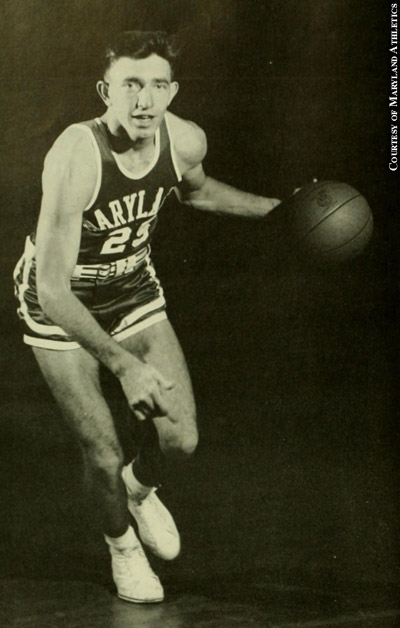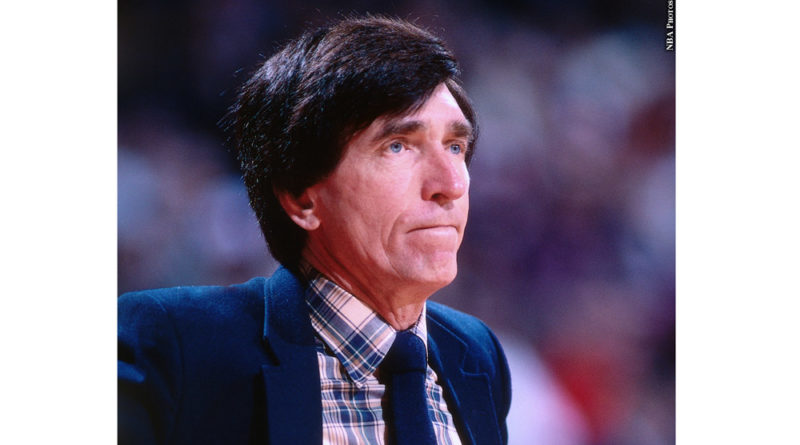Whenever the subject of basketball and the old Towson Catholic High School is mentioned, the first name that invariably comes up is Carmelo Anthony. But a few generations before, when there were only nine professional teams, there was another former Owl who paved the path to the National Basketball Association.

Gene Shue, who passed away at his home in Marina Del Ray, Calif., on April 3 at the age of 90, was arguably the best hoopster to come out of the city before Anthony blazed his own trail five decades later. Shue honed his skills on the famed Willow Avenue playground in the Govans area of North Baltimore before becoming a star at T.C. and an All-American at the University of Maryland.
He would go on to have a 10-year playing career, becoming a five-time All-Star and two-time All-NBA honoree while ranking in the top 10 in scoring and top 20 in assists at the height of his career. He then spent decades scouting, coaching and working as a front-office executive in the NBA.
Along the way, Shue was probably the only player whose career was admittedly strongly influenced by a former referee. Charlie Eckman, well known in these parts later as a colorful radio personality, had made the unusual transition from top NBA official to the head coaching job of the Fort Wayne Zollner Pistons. His famous line after taking the job was, “There are only two plays, ‘South Pacific’ and put the ball in the basket.”
And Eckman may have been the only person in the NBA who believed Shue could put the ball in the basket with the best players in the game. After being drafted in the first round with the third pick of the 1954 draft by the Philadelphia Warriors, Shue was sold after a handful of games to the New York Knicks, with whom he languished for two seasons.
Eckman, who at one point early in his career was refereeing games at three levels — high school, college and pro — had his own scouting report and convinced owner Fred Zollner to trade journeyman Ron Sobie to the Knicks in exchange for Shue after the 1955-56 season.
The Pistons, who had won a couple of Western Division titles previously, moved to Detroit, where Eckman got fired (“they said they were going to make a change in my department … and I realized I was the only one in that department”). Shue eventually blossomed into a top NBA scorer. He always acknowledged that “Charlie had the most influence on my career.”
Few would know, or remember, this today, but Shue was one of the first, if not first, to develop the “spin move” to set up a jump shot. He was known to spin from center court back to his left for an unerring jumper, which usually glanced off the blackboard. In addition to his offensive skills, he was one of the league’s best defenders and would have been a perennial on the All-Defensive team if the NBA had that back in those days.
After five years with the Pistons (1957-1962), Shue was dealt back to New York, where he once again languished and threatened to retire to the insurance business if he wasn’t traded to Baltimore, which had acquired the Chicago franchise for the 1963-64 season. A deal was finally struck, with Paul Hogue joining him in the trade to the Bullets, who sent Bill (The Hill) McGill to the Knicks in exchange.
But with the season already underway and having missed training camp, the last year of his career did not work out the way Shue hoped. After a brief stint as a starter, he played briefly and averaged only 4.2 points per game. Even reaching the 10,000-point milestone (a big number in those days) was a disappointment as nobody realized it until after the fact.
Not long after, Shue moved into the coaching ranks with the Bullets, who developed into one of the NBA’s most exciting teams under his watch thanks to back-to-back first-round draft choices Earl Monroe (1967) and Wes Unseld (1968).
Shue may have been among the first to use the so-called spin move, but he knew Monroe took it to a much higher level, and coupled with Unseld’s rebounding skills, the dynamic play of Gus Johnson, the shooting ability of Jack Marin and Kevin Loughery and the strong presence of Ray Scott and Fred Carter, those Bullets teams still rank among the NBA’s most exciting. The seven-game playoff encounters with the Knicks in 1970 (when New York won it all) and 1971 (when the Bullets lost to the Bucks in the finals) are still YouTube highlight reels.
Even though the Bullets posted a 52-30 record their last year in Baltimore (1972-73), Shue was replaced by K.C. Jones the next year. Shue moved on to the Philadelphia 76ers and San Diego Clippers before returning to coach the Bullets. He then completed his coaching career with the Los Angeles Clippers. His overall record of 784-861 is more of a reflection of the condition of the teams he took over than the overall skills he brought to the task.
Shue never won an NBA championship as either a player or coach, but it was a long ride from the concrete courts of Willow Ave. In any future discussions of Towson Catholic basketball, Carmelo Anthony may rank as the Ultimate, but Gene Shue will always be known as the Original Owl.
Jim Henneman can be reached at JimH@pressboxonline.com
Photo Credit: NBA Photos

